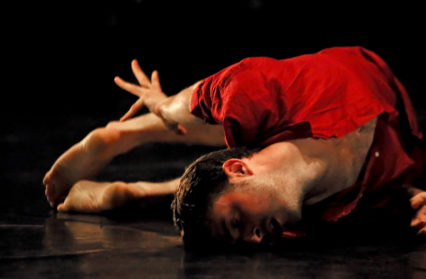Jane Oriel spoke with Gwyn Emberton on his company, Gwyn Emberton Dance’s production of Dance Roads, an interactive performance tour.
Dance Roads is an international performance tour, featuring the work of innovative choreographers from Wales, France, the Netherlands, Italy and Romania. The European partnership programme presents five short works to each country represented on the tour, giving audiences (both novice and regulars) the opportunity to experience fresh, new works from their own nation and the four others.
The process is designed to be both informative and enlightening for performer and observer, with a third element being the opening of a dialogue on how audiences experience dance and how this relationship can be strengthened, improved and expanded.
Long recognising a need to strengthen the position of dance in Wales (which stands in comparative shadow beside other arts in which the Welsh excel), Jane Oriel had this issue in mind when speaking with Gwyn Emberton, the founder and choreographer of the award winning Gwyn Emberton Dance, last week while he was in Bucharest on the Romanian leg of the Dance Roads tour.
Jane Oriel: How have audiences been responding to Dance Roads on the Continent and are you learning anything about how dance is experienced in different places?
Gwyn Emberton: Audiences respond very differently to different things. Tastes are different but they can recognise quality even if it isn’t something that they are particularly into. I am learning more and more, and not just on this tour, that you can’t please everyone with everything as a maker, and that audiences are usually supportive of work that comes from further afield. They like to taste difference, experience things that are a bit unusual, and they like to be challenged.
Jane Oriel: The Dance Roads performances are at Chapter Arts Centre on June 7th and 8th, with a daytime discussion with invited critics and journalists when the subject of audience engagement will be discussed. This sounds like a chewy subject. As with any art form, there is a necessary but sometimes uncomfortable relationship between art and money, be it revenue or funding. What do you think can be done to develop a larger audience but without sacrificing quality?
Gwyn Emberton: That is the 64-billion-dollar question. If we are talking about Wales, we need to have a joined up approach for dance. As artists and producers, we need to be working with venues and programmers in supporting them, in selling our work to their audiences and helping to support them too, not to educate but to offer insight into the ‘stage’.
I think we have a slight culture of ‘art isn’t for us’ in large parts of the UK which doesn’t exist so much in the rest of Europe. This comes down to fostering an appreciation of arts and culture at school level. I also believe that in dance, we need to raise the discourse about what dance in Wales is. We have lots of brilliant artists here who are making really interesting, reflecting, engaging work but it isn’t reaching beyond the ‘scene’. We need something that raises this in terms of the national consciousness – perhaps with a conservatoire? There are a few university degrees for dance now in South Wales, so perhaps this discourse will eventually happen more widely. We have RWCMD which has done amazing things for both theatre and music in Wales and for the perception of Welsh work outside of Wales, so why not for dance?
Jane Oriel: I saw and reviewed both GED’s Shadow of a Quiet Society and then Gary Clark’s COAL within a month of each other. Both use a narrative to tell a story, albeit with at times, an abstract interpretation. Do you think this ‘story lines’ way of telling a story through dance is a key way to attract a wider audience?
Gwyn Emberton: I will answer this in a roundabout way. I have felt and often heard that people are put off from seeing dance because they have a fear of not understanding what they will see. The most wonderful thing about contemporary dance is that there is no right or wrong way to view it. There is no right or wrong. IF we could somehow let audiences know that they can use their imagination, that what they see on stage is only the beginning of what they could experience, everyone would enjoy it. My sister’s children are wildly creative and imaginative but we lose this as we get older for fear of getting it wrong. This is such a shame.
One more point; narrative work helps reach into the imagination but can also limit it. I try to keep a sense of ambiguity to allow the imagination to take over and reach inside so that the interpretation is unique to the individual. Above everything, I think quality is the key to attracting audiences.
Jane Oriel: If people are at ease with their imaginations, all well and good – but the big question is how to encourage people to trust themselves?
Gwyn Emberton: Yes, that is the big question. I hope that over time, as more people see my work and hopefully return, they will feel more at ease with this concept and take bolder risks in what else they see. We, as artists, have to be aware of what we are making and how we are communicating to audiences, but we also need to be able to make work that is truthful for us. This is where we need to work as a community, artists, programmers, critics to support audiences in feeling that dance is ok for them.
Like I said, we have a lot of great work being made in Wales. It feels like it is a really special time for dance and there has been a lot of support over the three years since I have been back here which has made this happen. We need to be brave to keep this momentum going. We need to keep working on bringing the audiences in and on this journey with us.
Jane Oriel: As a young person, when did you know that making your career in dance was what you wanted to do?
Gwyn Emberton: It all started by accident. Initially, I went to college to study performing arts for acting but fell into dance with some gentle encouragement from various teachers. Dance seemed to work for me so in 1996 when I was 18, I decided to apply for dance courses at university instead of drama. After my first year at uni, I became involved in the National Youth Dance Company and I really understood how much I wanted to dance as a career and how much I wanted to, and enjoyed, working hard to get it. I was really inspired by the other dancers at NYDC who were training at London Contemporary Dance School, Rambert etc. and choreographers such as Wayne MacGregor, Mark Baldwin and lots of other amazing ‘choreogs’.
Jane Oriel: How long did it take for Gwyn Emberton Dance to become a reality? And did it come into being as a direct result of your returning to Wales?
Gwyn Emberton: They sort of happened at the same time. I had had a few years out of dance (I call it my other life), and started making a return by helping a friend with their theatre/multi-genre project in London. I realised that I missed performing, and being immersed in making it, that I decided to inch my way back in.
I started with a short duet for a platform for emerging ‘choreogs’ in London and it was a tough process for me. No money, little time and lack of a creative guide because I had been out for a few years. I knew I wanted to make more and needed time to do this. I was already spending more and more time at home in Montgomery with my family due to various reasons and someone suggested maybe I should investigate the possibilities of working in Wales. This was something I hadn’t thought of since I was 21. This all happened in 2012 and I began researching our first dance, My People, in 2013 as Emberton Dance – although we were not yet a proper company. The company only properly formed last year once I felt it was the right thing and right time to do. It also felt right that the company be formed in Wales as this is where I am happiest making work and actually, the work to date has been so inspired by this return. It has been hard work but I have had lots of amazing support.
Jane Oriel: When you design a piece and bring it into shape with your dancers over the weeks, how can you maintain your original vision – or does that not matter?
Gwyn Emberton: Good question. I usually have an overall atmosphere, feel or look with a fairly clear scenographic idea in mind. This will inevitably shift in the process but this original ‘state’ usually gives me the boundaries and parameters that I can work in. For my next work, I am trying to keep a more open approach but I have ideas already, so perhaps it will be a losing battle.
Jane Oriel: For your recent production, Shadow of a Quiet Society, each dancer came from a different country so GED wouldn’t seem to be a specific a Welsh entity. Do you think you could be based anywhere and still create?
Gwyn Emberton: I like making my work in Wales. It feeds the creation and the space, particularly in Aberystwyth, which really helps me focus and allows me to be immersed in the creation process. I am happy to make anywhere else too but for the company, it is really important that we are working in Wales. The dancers are international by accident. It happens because of auditions and who happens to be right for the work I am waiting to make.
Jane Oriel: Returning to Dance Roads, has it been possible to notice identifiable national differences in the approach to dance from the other four countries? – I’m wondering about any national arching concerns or traditions that have been translated into this physical medium.
Gwyn Emberton: That is hard to say for several reasons. Dancers are international by nature and pretty much all the choreographers have worked in multiple countries so the influences tend to be much more fluid and personal. However, I am aware that we all make work for the audiences we most particularly associate with, and who will perhaps see the work more.
Jane Oriel: Referencing your last point, what’s next for Gwyn Emberton Dance for this year and beyond?
Gwyn Emberton: We have a further tour of Shadow of a Quiet Society in the Autumn with dates in Cardiff, Bristol and Caernarfon. I will rework the piece a bit so those who saw it in February will see a bit of change. Eddie Ladd will be in it this time and will bring a whole new quality to it.
I am also working on another international project (again with Eddie), where we will be holding residencies in various European countries to make a collaborative piece between five international dance makers. The result will be touring Wales in February 2017 but the Wales residencies are at the end of October, into November this year when we will have open rehearsals and sharings.
Also, and very excitingly, we hope to start work on a new project inspired by the refugee crisis that’s very much rooted in the idea of place, displacement and leaving. We have a very exciting composer working with us for that and it will just be R&D at the end of the year and hopefully a new production for autumn 2017. Finally, there are performances of Caitlin coming up in Wales in a few weeks, in June and July, if I can plug them….
Dance Roads http://www.chapter.org/dance-roads












